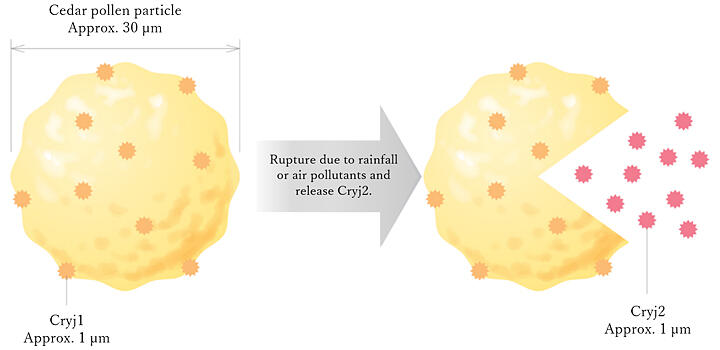FUJIFILM has discovered that the antigenic protein 'Cryj2' in cedar pollen is one of the causes of disrupting the skin barrier, inducing skin problems such as age spots and dullness. They further discovered that mulberry (Morus alba) root-bark extract, a herbal medicinal ingredient with known anti-inflammatory properties, reduces the negative effects of Cryj2 on skin. The company will apply the research results to cosmetics development in the future. They presented the achievement at the 46th Annual Meeting of the Molecular Biology Society of Japan (MBSJ2023), which was held at Kobe Port Island from December 6.

Provided by FUJIFILM
Cedar pollen is known to cause allergic symptoms such as sneezing and a runny nose as well as skin problems like itching and redness. These are thought to be caused by the antigenic proteins Cryj1 and Cryj2, which are present in the outer coat and inner layer of cedar pollen, respectively. In the field of dermatology, Cryj1 is known to disrupt the skin barrier function and cause skin inflammation. However, details of the effect of Cryj2 on skin had yet to be clarified.
The company focused on the fact that cedar pollen ruptures upon contact with moisture and air pollutants, such as fine particulate matter of less than 2.5 micrometer diameter (PM2.5) and studied the effect of cedar pollen derived Cryj2 on skin. They first worked on visualizing Cryj2. They ruptured cedar pollens by soaking them in water and then used antibodies to stain the released Cryj2, successfully visualizing the molecules.
Using human epidermal cells, they examined if Cryj2 released outside of cedar pollen adheres to skin to cause barrier function disruption and the formation of age spots and dullness. Specifically, they focused on involucrin (INV, an important factor for maintaining skin barrier function) and stem cell factor (SCF, a factor involved in forming age spots and skin dullness). They experimentally investigated changes in the expression level of the genes coding for INV and SCF in human epidermal cells in the presence or absence of Cryj2.
As a result, in human epidermal cells exposed to Cryj2, the expression level of the gene coding for INV for maintaining skin barrier function was found to be reduced by approximately 30% compared with that in cells not exposed to the antigenic protein, whereas the expression of the gene encoding SCF that causes age spots increased by 2 folds. These results indicate that Cryj2 adherence to skin is a cause of reduced skin barrier function and the formation of age spots and skin dullness.
Furthermore, in searching for cosmetic ingredients to suppress the effects of Cryj2 on skin, the research group selected mulberry root-bark extract (a herbal medicine with anti-inflammatory properties). They added both mulberry root-bark extract and Cryj2 to human epidermal cells and compared the expression levels of the INV/SCF-coding genes with the levels in human epidermal cells exposed to Cryj2 only.
In the human epidermal cells exposed to both mulberry root-bark extract and Cryj2, the INV gene expression level increased by approximately 50%, while the SCF gene expression level decreased by approximately 40%, relative to the levels in the cells exposed to Cryj2 alone. Through this the research group discovered that mulberry root-bark extract can reduce the negative effect of Cryj2 on the skin barrier function, thereby suppress the unfavorable factors related to age spots and skin dullness.
This article has been translated by JST with permission from The Science News Ltd. (https://sci-news.co.jp/). Unauthorized reproduction of the article and photographs is prohibited.




